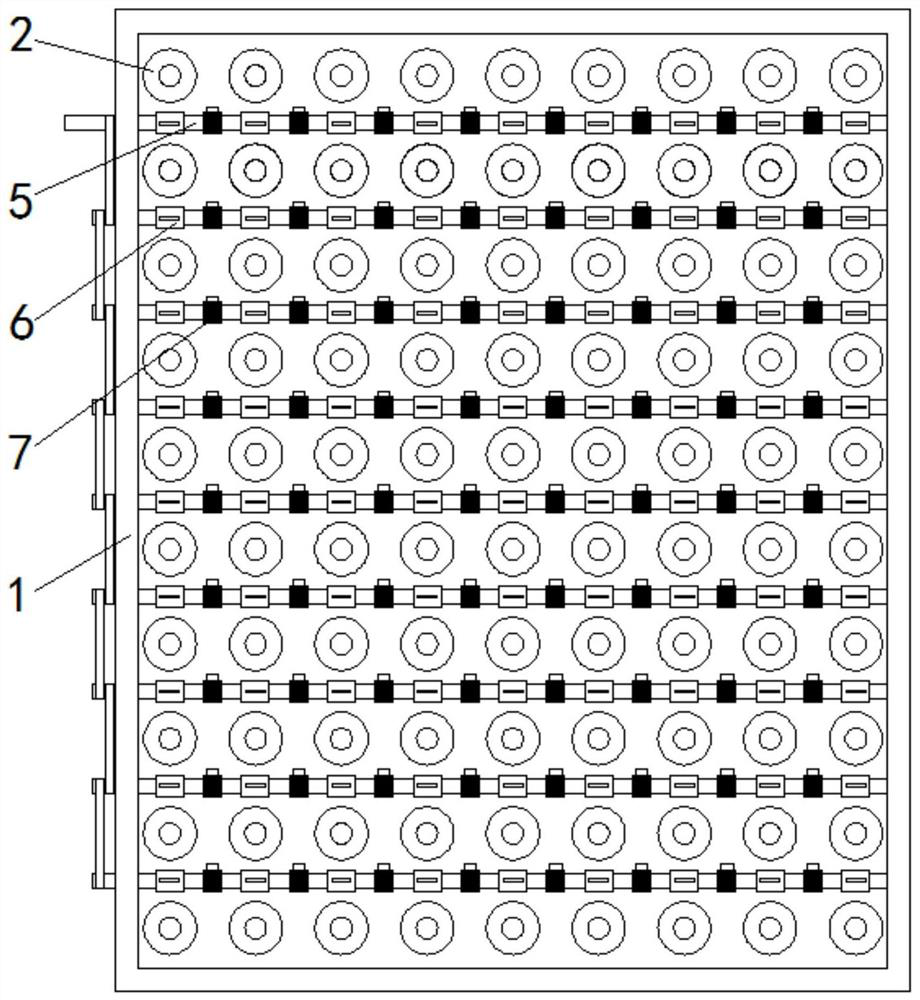Salt-resistant high-yield new variety rice seedling cultivation method
A breeding method and technology for new varieties, applied in rice cultivation, horticultural methods, botanical equipment and methods, etc., can solve problems such as inability to increase crop yield, increase in agricultural planting costs, and inability to arrange seedlings in an orderly manner, so as to achieve convenient observation and Easy to measure, plant, and easy to take out
- Summary
- Abstract
- Description
- Claims
- Application Information
AI Technical Summary
Problems solved by technology
Method used
Image
Examples
Embodiment 1
[0032] A method for cultivating seedlings of a new variety of salt-tolerant and high-yield rice, comprising the following steps:
[0033] S1. Seed selection: (1) Take the culture soil and evenly lay it on the seedling tray, then spray the sodium chloride solution evenly on the bed surface, so that the salt content in the soil is 0.6%, and put the rice varieties to be selected on the 27 Soak in water at ℃ for 2 days:
[0034] (2) select 100 kinds of dipped rice varieties on the seedling tray of spraying sodium chloride solution, be placed in 29 ℃ of temperature to germinate, and get another 100 seeds and make contrast on the seedling tray that is not sprayed with sodium chloride solution;
[0035] (3) After germination, place it at a temperature of 25°C for growth, investigate after 10 days, and compare the height of the seedlings treated with sodium chloride and the normal growth seedlings; Those with less than 20% are salt-tolerant rice varieties; those with lower 21-35% are...
Embodiment 2
[0041] A method for cultivating seedlings of a new variety of salt-tolerant and high-yield rice, comprising the following steps:
[0042] S1. Seed selection: (1) Take the culture soil and evenly lay it on the seedling tray, then spray the sodium chloride solution evenly on the bed surface, so that the salt content in the soil is 0.8%, and put the rice varieties to be selected on the 28 Soak in water at ℃ for 4 days:
[0043] (2) select 100 kinds of dipped rice varieties on the seedling tray of spraying sodium chloride solution, be placed in 30 ℃ of temperature to germinate, and get another 100 seeds and make contrast on the seedling tray that is not sprayed with sodium chloride solution;
[0044](3) After germination, place it at a temperature of 26 °C for growth, investigate after 10 days, and compare the height of the seedlings treated with sodium chloride and the normal growth seedlings; Those with less than 20% are salt-tolerant rice varieties; those with lower 21-35% are...
Embodiment 3
[0050] see Figure 1-Figure 4 , a method for cultivating seedlings of a new variety of salt-tolerant and high-yield rice, comprising the following steps:
[0051] S1. Seed selection: (1) Take the culture soil and evenly lay it on the seedling tray, then spray the sodium chloride solution evenly on the bed surface, so that the salt content in the soil is 0.6-0.8%, and put the rice varieties to be selected into the seedlings. Soak in water at 27-28°C for 2-4 days:
[0052] (2) 100 seeds of selected dipped rice varieties are placed on the seedling trays sprayed with sodium chloride solution, placed at a temperature of 29 to 30 ° C for germination, and another 100 seeds are taken on the seedling trays that are not sprayed with sodium chloride solution. control;
[0053] (3) After germination, place it at a temperature of 25 to 26°C for growth, investigate after 10 days, and compare the height of the seedlings treated with sodium chloride with those of the normal growth seedlings...
PUM
 Login to View More
Login to View More Abstract
Description
Claims
Application Information
 Login to View More
Login to View More - R&D
- Intellectual Property
- Life Sciences
- Materials
- Tech Scout
- Unparalleled Data Quality
- Higher Quality Content
- 60% Fewer Hallucinations
Browse by: Latest US Patents, China's latest patents, Technical Efficacy Thesaurus, Application Domain, Technology Topic, Popular Technical Reports.
© 2025 PatSnap. All rights reserved.Legal|Privacy policy|Modern Slavery Act Transparency Statement|Sitemap|About US| Contact US: help@patsnap.com



